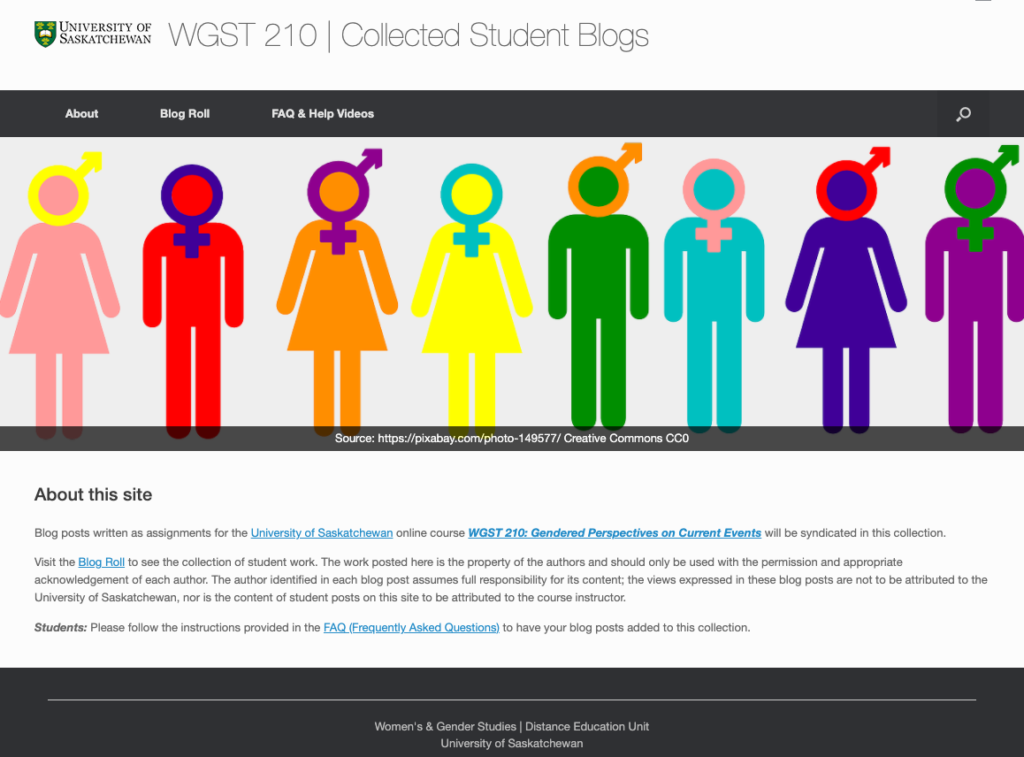When designing online courses, it can be helpful to consider in which ways you, as the instructor, might make best use of the online format. What forms of assessment, types of media, or platforms for student interaction will help you and your students take advantage of the online and completely digital and distributed format? In this article, we present a case study of how student blogs are being used in WGST 210 to increase student engagement, build interconnectivity in student work, and help students lean more fully into the internet-immersed and media-focused aspects of the course.
Why Blogs?
This project begain as part of a major update to the course WGST 210: Gendered Perspectives on Current Events. Early on in our course re-design conversations, Subject Matter Expert and instructor Dr. Carrie Prefontaine connected with an Instructional Designer (Julie Maier with the GMCTL) for additional support, and expressed an interest in switching from more static forms of writing assignments (i.e., regular ol’ research papers) to using student blogs instead. But why? — what could students do with blogs that they could not do with a research paper?
Because the course focuses so heavily on current events, and the narratives and discourses that arise around those events in “mainstream and alternative media”, Dr. Prefontaine wanted to give her students a writing platform that would allow them to analyze media from around the web with a more interactive, dynamic, and in situ approach. With a blog, students could comment upon various media items (e.g., news articles, videos, social media posts, tweets, other blogs, etc.) while embedding that same media in context, right within their own analytical writing.
Students could also link to, contribute to, and expand upon, gender-based conversations happening elsewhere on the web, and do so in a medium and format that is reflective of, and consistent with, those existing conversations.
Additionally, students working on their own blogs would be able to develop valuable new technical skills and digital literacies related to web design, online publishing, and the WordPress platform in particular.
Lastly, students working on blog posts that were collected into a central place would be able to benefit from also seeing the work and insights of their classmates, and through this open network of shared conversations would hopefully be motivated to produce a high calibre of work.
Assignment Guidelines and Assessment
As with any writing assignment, it was important to give students a clear set of expectations for how they should approach their blog writing assignments, and what formatting or referencing conventions they should follow. When blogging in an academic context, the key is to help students strike a balance that allows for a more informal tone while still maintaining academic rigour and solid research and writing skills.
To start, each module (of 12) in WGST 210 gave students a selection of Blog Prompts from which they could choose to respond to in their next blog post. It was important that these prompts be written with clear direction, while also leaving room for students to explore topics deeply and also develop their own unique analytical discussions. It was also really important that the writing prompts tied back to the Learning Objectives for the module, as this was a key format for student assessment in the course. For example, here were the choices for Module 1:
WGST 210 Blog Post Prompts for Module 1:
-
- In his documentary, The Gods of Our Fathers (see Supplemental Resources), Gwynne Dyer claims that “patriarchy is in our heads, not in our genes.” Using the assigned readings from this module, assess this claim. What do you think he means? Do you agree or disagree? Why? What are the implications for social inequalities? [Category: mod1blog1]
- Spend some time reading media coverage of an ongoing current event of your choice. Analyze the use of language in at least one resource. Do you see any evidence of binary thinking in that resource? Identify specific examples. What are, in your opinion, possible implications for social inequalities? Be sure to provide a link to your chosen resource in your blog post. [Category: mod1blog2]
- This module only briefly touched on the critiques of Western feminism made by Indigenous feminists. Spend some time exploring the blogosphere, and write a post that summarizes several of the critiques that Indigenous scholars have made of Western feminism. [Category: mod1blog3]
*note: the utility of the “Category” is explained later in this article.
While every Module contained these writing prompts, students were only required to complete 5 blog posts during the entire course. As such, they had lots of flexibility and autonomy to respond to the topics that were most interesting or engaging for them. Submission deadlines based on Module were set at 3 different points in the course, to ensure that students weren’t all submitting their work at the end of the term.
Along with the selection of writing prompts, Dr. Prefontaine (with support from an Instructional Designer) developed a clear set of Writing Guidelines, including the following:
WGST 210 Blogging Guidelines:
-
- Blog posts are shorter and less formal writing assignments, but will be marked as rigorously as the term research paper. Students are expected to do proper research, use good writing mechanics, and include citations/references where necessary.
- Word count: blog posts should be 500-750 words long.
- Posts should incorporate hyperlinks, embedded images, embedded media, embedded social media posts/tweets, and GIFs as needed to provide sufficient evidence and support for your argument.
- For a list of what embedded media WordPress blogs support, see https://wordpress.org/support/article/embeds/.
- Any researched information used directly in your blog must be cited in the MLA style. Students are expected to use in-text citations and provide a Works Cited section at the end of each post, as well as an Attributions list giving the sources for any embedded media (such as images or GIFs).
- Make sure you use strong, credible academic or journalistic sources (online or print).
- Gossip magazines or websites (e.g., People, Hollywood Reporter, TMZ) should be avoided, as their purpose is not analysis or objective reporting.
- If you are not sure if your source is credible, UBC has a great guide on how to evaluate sources found at: http://wiki.ubc.ca/Library:Evaluating_Information_Sources
- Any evidence of plagiarism will result in a mark of zero for that post.
- Posts should include your own personal analysis, and may be written in informal language. Feel free to entertain, but do not lose sight of your purpose.
Evaluation criteria was made clear to students by providing them the Rubric that the instructor would be using to grade the blog posts, so they would have a good understanding in advance of how their work would be later assessed and graded. If you’d like to borrow it, the rubric has been shared here with a CC BY-NC-SA 4.0 licence; feel free to take it and adapt it to fit the needs of your own course!
Technical Setup and Considerations

The technical setup for this blogging assignment required a few steps:
-
- First, the GMCTL assisted Dr. Prefontaine with setting up a home site for her course; this was created using WordPress on the sites.usask.ca network, with the instructor given Administrator privileges. While a password is optional, at the instructor’s request this home site has been password-protected so that only WGST 210 students have access.
- Using her list of enrolled students, Dr. Prefontaine submitted a request to ICT to generate individual blogs for all of the students in her course.
- An Instructional Designer helped Dr. Prefontaine create a list of Frequently Asked Questions (FAQ) and a WordPress Help Video, and added these to the home site. This information would guide students through setting up and accessing their blogs, along with a basic walkthrough on making their first blog post in WordPress. This information was essential for students to seek self-help technical assistance when it was needed, and to minimize how much direct assistance the instructor and/or USask ICT might need to provide. The FAQ has since been updated a few times, to adapt to the questions and issues that students commonly bring forth.
- Dr. Prefontaine collected the URLs of the student blogs, and used them to set up syndication on the home site, enabling a centralized blog roll that would collect all of the posts from individual student blogs. (See also: Setting Up Syndicated WordPress Blogs).
- A system of Categories was also added to the home site menu, so that student blog posts, if they were marked with the correct Categories, could be sorted according to the blog post prompt they were responding to. This would aid both instructor and student navigation of the blog roll.
- On the LMS side of the course (first Blackboard, then later Canvas), some basic directions to point students towards the WordPress content was posted. Assignment submission dropboxes were also set up to give students a place to submit their work when it was ready for grading (i.e., by submitting the URL for their blog entry through the LMS). In this way, all of the grading would still be handled through the LMS and kept in the secure Grade Book therein.
The GMCTL Instructional Designer on this project (Julie Maier) assisted with much of this setup and helped to coach Dr. Prefontaine through some technical WordPress stuff the first time around. However, after that, Dr. Prefontaine was off and running with using the blog for student assessment, and also started using her own blog posts, organized by the Category of “profsposts”, to communicate regular class updates!
How Has Blogging Impacted Student Learning?
The following is a quote from Dr. Carrie Prefontaine describing the learning benefits she has seen after several terms of student blogging in WGST 210:
Students are responsible for the initial setup of the blogs at the beginning of the course, and, using the current process, this step requires a time investment. Once students have their blogs set up, they have demonstrated enthusiasm for and engagement in the assignment. Many students have used the blogging assignment as a foundation for developing research questions that they have explored in their major assignments for the course.
This is Cool! How Do I Get My Own Class Blogs?
Go to the sites.usask.ca homepage and find the form at Get Sites For Your Whole Class. Fill out the form, and support staff will be in touch to discuss the setup, and make sure you have all of the pedagogical and technical supports you need to proceed.



